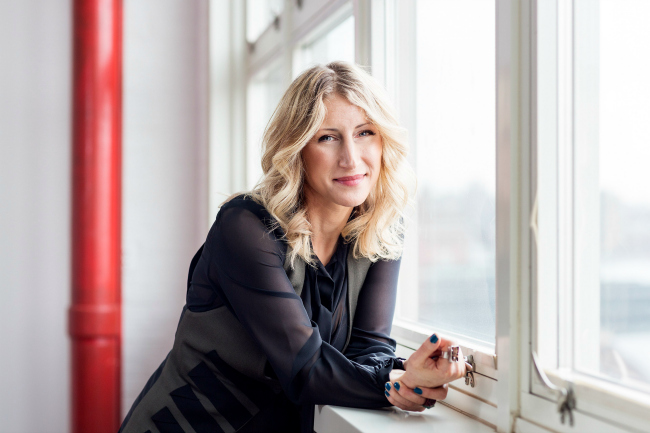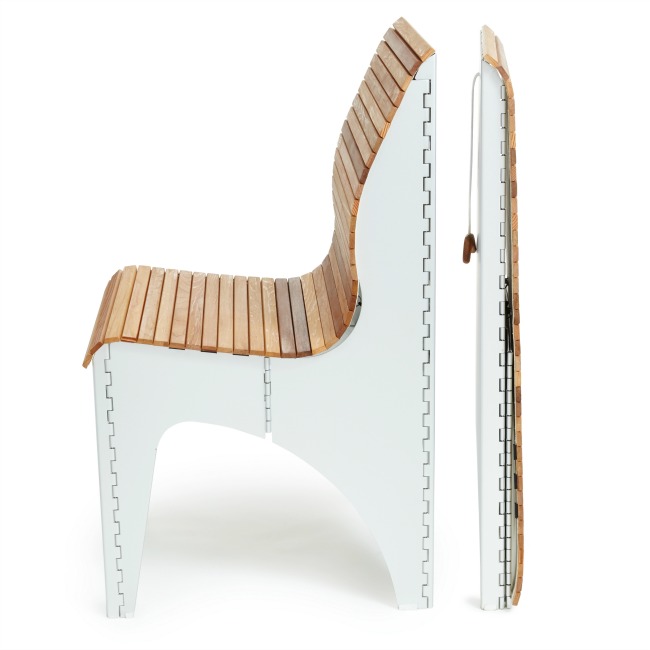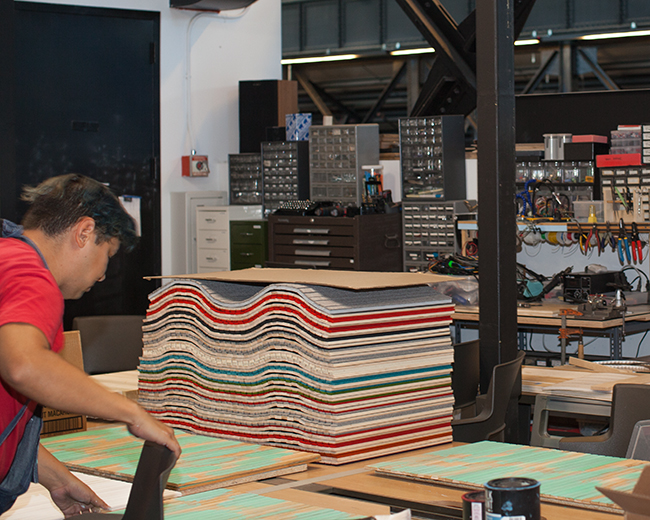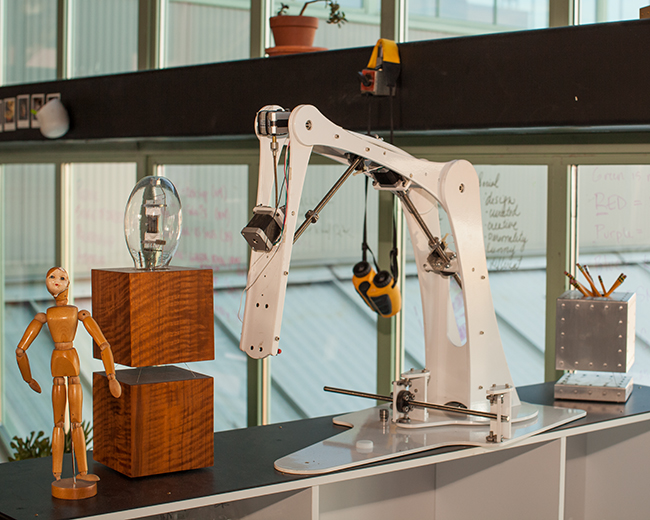*Editor’s note: The Shape-Shifting Ollie Chair is coming soon to our assortment. Be the first to get it by pre-ordering here.
“I like creating objects that move and change and don’t always stay what they seem to be,” says Ollie chair designer Jess Banks. Transformation is everywhere you turn at her studio in the Brooklyn Navy Yard. It starts with the building itself. The jaw-dropping space of the New Lab, where Jess and her team develop their kinetic designs, was once part of a shipbuilding mecca. The space is now a high-tech entrepreneurial hub. “It’s really amazing to think of how we’re based in a place that was running because of war, and I’m allowed the freedom and luxury to create new ideas,” she reflected. This is just the sort of place you’d expect to find a chair that unfurls from a two-inch-thick rectangle of aluminum and wood tambour—and transforms back again with a gentle pull.
We visited Jess to discuss design inspirations for her shape-shifting chair, the personalities behind it, and why she doesn’t call it a “folding chair.” Along the way, we learned more about tambour and discovered why the former Comedy Central employee looks forward to buying toothpaste.

Folding chairs have been around for a long time in various incarnations—seems like an interesting challenge to take on reinventing that form.
We actually never call it “folding chair” because I think that pigeonholes us psychologically and for the consumer as a $39.99 thing that you might forget at the beach when it gets too windy or something.
And something that nobody really wants to sit on either!
Exactly. And something that you intentionally hide, right? And that’s like secondary seating. But the way we see living and working progressing is that people want versatility every day. It’s not that you want to have it as a secondary option—you want versatility to be a primary element of your lifestyle. So, we don’t say, This is a “folding chair” that you’re going to store away. This is your normal chair. We don’t look at it as This is your secondary chair you’re going to bring out when guests come. This is your everyday chair that you can move when you want to do yoga.
Tell me about the name for the Ollie Chair. Did you have a best friend named Ollie?
When we develop each of our products, we associate persona with the product and the product collection. It helps us to differentiate each collection because we really value individuality and expression, so we want each of our product lines to have its own personality. The Ollie collection seemed really rambunctious, vibrant, dynamic, and kind of radical and tough. So it seemed like a skateboarder. And an ollie is a skateboarding move, so we called it Ollie.

Studio photos by Eric Jackson-Forsberg, except where noted.
What were some of your inspirations for the form and function of the chair?
Often our inspiration comes from a physical principle. We started thinking of fluid dynamics and cascades of water because when we first started working on Ollie we worked on the table first (which we have downstairs), and we wanted it to cascade down the wall. So we really start there. Of course, inspiration comes from everywhere: From a lot of visual mistakes and things you see in the world that other people do. It becomes integrated.
Tell me a little more about tambour—I think of a roll-top desk
Tambour is a material that has slatted pieces adhered to a backing so it can be flexible. Often in bread boxes or roll-top desks or sometimes screens. The tambour usually bends only in one direction, so it rolls up or down but can’t flip back up the other way. We had to do a modification on a conventional tambour so that ours can go in both directions because it has to follow a contour. We put chamfers on both sides of each slat, so they have an angle that allows them to be able to bend in both directions. Implementing this notion of a tambour meant that we could then play with things that go from flexible to rigid.
What are some of your favorite materials to work with?
[Laughs] At this point, I’d rather be working with something like feathers that’s light, compressible, soft, and easy to work with. But I am really material agnostic. In fact, I want to search for new materials to work with all the time because I like to learn about these things. Of course, I love working with wood. I love Corian, which is amazing and soft and supple to work with. I love fiber optic cables. I love working with light.What do you like about designing kinetic furnishings—what are the advantages?
I like creation of objects that move and change and don’t always stay what they seem to be. I think also what’s important for me is that I give people an experience. So I don’t think necessarily about creating objects, I think about creating experiences for people through those objects. But elements of surprise and wonder that can make people feel empowered by their knowledge and curious about the world.
What are your most essential tools?
My hands. My smile. I think many people go to “my hammer,” but in business, I think it’s an understanding of rapport and of myself. But I have this little scraper tool that I love. It’s just a straight blade attached to a handle, and I find it tremendously effective for a lot of different things—not even for just building furniture. I love gauges, though—I have a little collection of gauges. I love measurement. I love calipers, too. I probably use my calipers more than I use anything else these days.
Can you tell me about the collaboration that went into this design?
Pete [Schlebecker] is our head of fabrication. He and I worked really closely together on all the design and engineering parts. He’s a master woodworker and tremendous product designer. And Pete has a furniture background. I can build and engineer things, and Pete understands how to work with wood and put together things that are supposed to be used as furniture. We go back and forth until we find a good compromise of something that is functional as furniture but also aesthetically pleasing.
How do you find inspiration in your workspace?
I have extra peripheral vision (which is a funny thing about my eyes), so I actually prefer spaces that are very minimal and don’t have a lot of visual chaos. Here, it’s almost hard to avoid because we’re doing so much stuff and we want to show what we’re doing. We’re reminded of certain things so we keep the visual reminders out. But we try to separate at least the chaos of fabrication from the chaos of the computer workspace. Comfort is a big deal for me. I’m a huge proponent of a nap in the afternoon or of sitting whatever way you want. Over there we have the “big blue sky” couch for meetings that faces out across the water and into the city so we can think beyond ourselves.
This is one of the old Navy Yard buildings that’s been repurposed. How does that affect your work?
I think there’s a gritty feeling to it that I appreciate, and the whole feel of the Navy Yard is very industrious. Sometimes when I’m here at night, if I’m the only one in the entire building, it’s just the dit deet doot of the 3D printers that are running. But sometimes I’m like, Come on, walls—say something! I know that you’ve heard so much stuff. Like, ships that won wars were built in here—the parts were built here—the Navy Yard used to have 70,000 people working in shifts of 23,000.
What’s the toughest lesson you learned when you started a business? What advice would you offer your past self?
I would tell myself to go read a good book and get over that impulse to have a company [laughing]. Or have a glass of wine. I think I would spend money faster. For a while when we had no funds, I was very stringent on the budget. But spending money will let you accelerate your entire company. And there’s another big lesson: Having a company doesn’t mean you get to do what you want to do. I don’t get to create. We work on one product for a year, two years. And my love and passion is to create products over and over and create one-offs.
When you’re that far removed from it, is it hard to find the next idea?
It’s not hard to find opportunities to have those ideas, because we have a buffer. Almost every couple weeks we come up with a new product that we’d like to put out, so we have a tremendous buffer of products that we’d like to do. It’s harder just to execute on them or run them through any kind of analysis of whether that product could actually be something to include in our repertoire.
How do you set goals for yourself?
My biggest goal is learning how to course correct quickly. In terms of everyday goals, sometimes it’s like, “Get this email out” or, “Figure out this engineering design.” I actually love things like running out of toothpaste because that to me feels like an actual, legitimate accomplishment. Whereas having so many ambiguous goals or ones that are tasks—it can really grate on the psyche to feel like you have no accomplishments, or that you’re only doing logistics. So I like mowing the lawn.
How do you celebrate success?
I have a tremendously hard time celebrating my successes. I see it in others and love to celebrate other people’s successes. But I think maybe it’s related to this ambiguous goal problem, that it’s very difficult for me to feel like I’ve accomplished anything. And I’m also extremely hard on myself. I don’t ever think anything’s done. There’s always room for improvement only because the world changes, people change, and so any single product needs to evolve. I mean, humans are a constantly evolving product, right?









No Comments